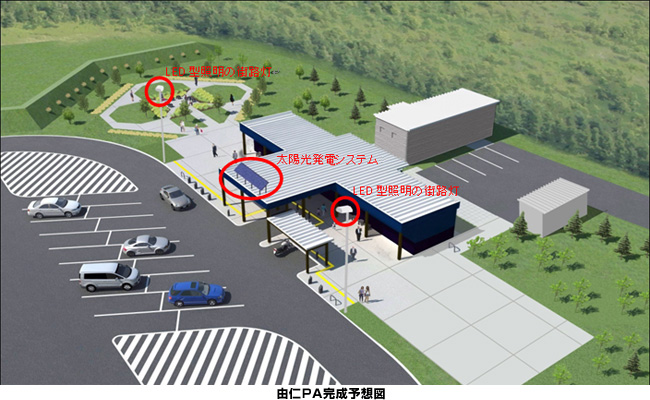道東自動車道・道央自動車道の開通について
―道央圏と道東圏が高速道路で直結、道南方面へ高速道路が延伸―
平成23年7月28日
東日本高速道路株式会社
NEXCO東日本(東京都千代田区)が建設を進めている道東自動車道夕張(ゆうばり)インターチェンジ(IC)から占冠(しむかっぷ)IC間、および道央自動車道森(もり)ICから落部(おとしべ)IC間が開通することになりました。
また、道東自動車道では、新たに由仁(ゆに)パーキングエリア(PA)、占冠(しむかっぷ)PAの2つの休憩施設がオープンします。
開通区間(箇所)及び開通日
道央自動車道 森IC~落部IC間(延長約20km) 平成23年11月26日(土)
道東自動車道 占冠PA 平成23年9月7日(水)
道東自動車道 由仁PA 平成23年10月29日(土)
開通区間概要
【道東自動車道 夕張IC~占冠IC間】
平成23年秋の開通予定として事業を進めてまいりました道東自動車道夕張IC~占冠IC間は、脆弱な地質のため難工事であった4,000mを超える穂別トンネルが貫通した後、道路の仕上げとなる舗装工事やトンネル防災等の設備工事、建築等の工事を鋭意進め、このたび開通することとなりました。
今回の開通により、道央圏と道東圏が高速道路により結ばれ、より安全・安心で快適なアクセスが確保され、物流の効率化、観光行動圏の拡大や地域間の連携強化などが期待されます。
(道東自動車道の詳しい情報は当社ホームページでもご紹介しておりますのでご覧ください。
【道央自動車道 森IC~落部IC間】
平成23年秋の開通予定として事業を進めてまいりました道央自動車道森ICから落部IC間は、国指定史跡の鷲ノ木遺跡部分のトンネル工事が完了した後、道路の仕上げとなる舗装工事や建築等の工事を鋭意進め、このたび開通することとなりました。
今回の開通により、道南方面へ高速道路が延伸し、定時性の向上による物流の機能強化に加え、大雨や津波などによる災害時の緊急輸送路としてのリダンダンシーが確保されます。
【道東自動車道 由仁PA、占冠PA】
平成23年度の完成予定として事業を進めてまいりました由仁PA、占冠PAの2つの休憩施設がこのたび道東自動車道に新たに完成します。
この2つのPAの完成により、高速道路をご利用されるお客さまの利便性がさらに向上します。
【位置図】

【今回開通区間の現在の状況】
■道東自動車道 夕張IC~占冠IC間

■道央自動車道 森IC~落部IC間

■道東自動車道 由仁PA

■道東自動車道 占冠PA

開通区間の特色



1.夕張IC~占冠IC間
(1) 開通区間の概要
道東自動車道は、十勝清水から池田間を平成2年より建設に着手し、平成7年に道東圏初の高速道路として開通しました。その後、千歳恵庭JCTから夕張間が開通し、夕張山地と日高山脈を貫く夕張~十勝清水間は、平成14年より工事を進め、平成19年にトマムから十勝清水間、平成21年に占冠からトマム間が順次開通してきました。
今回の開通区間は夕張山地の山岳地帯を貫く4,000m級のトンネル3本を含む8本のトンネルと20橋の橋梁からなる道路となっています。
(2) 脆弱地質におけるトンネル掘削の克服
今回の開通区間では、夕張山地の南端部に位置し、蛇紋岩(じゃもんがん)の分布規模が日本最大と言われる神居古潭変成帯(かむいこたんへんせいたい)をほぼ東西に貫いています。
蛇紋岩の特徴は、非常に脆くて膨張する性質があり、JR 石勝線などの建設においても難工事の原因となっていました。今回工事を行った穂別(ほべつ)・占冠(しむかっぷ)の2つのトンネルでは、土被り(トンネル上の土の厚さ)が大きいことからトンネル壁面への圧力も強く、脆弱(ぜいじゃく)な地質と相まって、掘削中に掘削先端部及びトンネル天井部の崩落やトンネル支保工(トンネルを支えている部材)の変形が多数発生しました。
これらの崩落対策として、鏡補強工(掘削先端部の崩落を防止)及び先受け工(天井部の崩落を防止)などの補助工法により、自立性を確保しつつ、高速道路のトンネルでは初めての採用となる高耐力二重支保工(高強度材料を用いた支保工を二重に設置)により、早期にトンネル断面を構築することで崩落を防止しました。また、インバート(トンネル底部の構造物)を極力円形に近づけた形状とすることでトンネル構造全体の安定化を図りました。
これら最新の技術を駆使して施工した夕張~占冠間のトンネル群の建設は、本年5月に「土木学会技術賞」を受賞しました。




2.森IC~落部IC間
(1) 開通区間の概要
今回開通する区間は、一般国道5号と並行し噴火湾に沿った位置を通過します。
平成11年より用地取得、平成12年より工事に着手し、事業を進めてきました。今回の開通区間は、用地買収が計画より早く進み、当初予定よりも約1年早く開通することとなりました。
工事では、国指定史跡の鷲ノ木遺跡をトンネル構造で保存するなど、3本のトンネルと13橋の橋梁を含め、切盛土工主体の道路となっています。
(2) 文化財保全「鷲ノ木遺跡トンネル」
鷲ノ木遺跡は平成14年に、当該区間の工事中に発見され、発掘調査により、約4,000年前(縄文時代後期)のもので、約600個の石で築かれた環状列石は、道内で発見されたなかでは最も大きく、また保存状態も極めて良いこと、さらに環状列石の傍らに堅穴墓域(たてあなぼいき)と呼ばれる珍しい遺構が伴う大変貴重な遺跡であることが分かりました。
このため、北海道並びに森町教育委員会と遺跡保存に向けた協議を行い、遺跡を存置するために、開削工法による切土構造から、遺跡直下を推進工法で貫くトンネル構造に変更しました。
工事では、貴重な文化遺産への影響を最小限に抑えるため、地盤変位を常時観測し適切な現場管理により工事を進め、最終的な地盤変位を僅か1cm以内に収めたことで、遺跡への影響を回避することができました。
なお、最新の技術を駆使して完成した鷲ノ木遺跡トンネルは、本年5月に「土木学会北海道支部技術賞」を受賞しました。
今回の開通区間では、自然豊かな地域を通過することから、様々な環境保全に取り組みました。
(1) 動物侵入防止等への対策
鹿などの大型動物の侵入防止として、フェンスの高さを2.5mにするとともに、キツネなどの小動物の侵入防止のために柵の下部の隙間を金網により塞いでおります。
万一高速道路内に鹿などの大型動物が侵入しても、迅速に路外へ脱出させるための「鹿追出し施設」を設置しています。
また、森IC~落部IC間では、鳥類(猛禽類)が走行中の車両と衝突するのを防止するために、鳥類の飛来コースに柵(ポール)を設置しました。


(2) 水辺空間に生息する生物の保全対策(ビオトープの整備)
夕張IC~占冠IC間では、既存の河川に生息する「ヘイケボタル」を保全するため、高速道路の建設により消失又は縮小する河川環境の復元及び保全を行いました。今回の事例では、河川の付替え・改修に合わせて、河川に淵、淀み、自然木を設け、水生生物や植物の生息・生育環境を復元しています。

(3) 電力消費量の低減に向けた取り組み
「ecoインター」の整備として、料金所室内照明や道路案内標識及び自発光スノーポールなどに電力消費量の少ないLED型照明を採用しています。
また、道内では初となる、LED型のトンネル照明を鷲ノ木遺跡トンネルに採用しております。

(4) 「ecoエリア」の整備
道東自動車道夕張IC~占冠IC間の開通に合わせ、今回由仁PA、占冠PAの2つの休憩施設がオープンします。これにより、長距離を運転されるお客様の利便性がさらに向上します。
この2つのPAでは、トイレ室内照明や建物前面の街路灯に電力消費量の少ないLED型照明を採用するなど、「ecoエリア」の整備を積極的に進めています。
また、由仁PAでは道内高速道路では初となる「太陽光発電システム」を試行採用するなど、地球温暖化防止に取り組んでいます。

整備効果
■道東自動車道
~道央圏と道東圏を結び、より安心で快適になりさらに旅行時間が短縮されます!~
道東自動車道の開通により、道内でも自然環境の豊かな山岳ルートである標高1,022mの日勝峠を回避して道央圏と道東圏の往来が可能となります。
道東自動車道は、一般国道274号の日勝峠と比較して標高が約400m下がり、また、道路の平面・縦断線形が大幅に改善されることから、交通事故の減少や霧による視程障害発生の減少、さらには冬期の交通障害発生リスクなどが減少し、より安全・安心で快適なアクセスが確保されます。
また、札幌市から帯広市までの旅行時間が、すべて一般道路利用(日勝峠ルート)に比べて、約80分短縮され、これにより物流の効率化、観光行動圏の拡大や地域間の連携強化が期待されます。

~地域の救急搬送の選択肢が拡大~
道東自動車道が整備されていなかった時の占冠村からの救急搬送は、富良野・旭川方面への搬送が主流でしたが、道東自動車道の開通により、高次救急医療機関がある帯広市、また札幌市への搬送先の選択肢がさらに拡大することで、地域の皆様の「安心・安全」に貢献します。
~道東圏がより身近に~
道東自動車道の開通により、地域間の移動時間が大幅に短縮されます。これにより、北海道の基幹産業である観光地への移動がスムーズになり、知床や釧路などの観光スポットを加えた「広域周遊型観光」など、新たな観光需要の増加が期待されます。
■道央自動車道
~道央圏と道南圏の更なる利便性の向上及び災害時のリダンダンシー機能が強化~
道央自動車道の開通延伸により、道央圏と道南圏の利便性が向上し、定時性・安全性が確保され、札幌市から函館市の旅行時間がすべて一般道路利用に比べ約80分短縮となり、観光行動圏の拡大や地域の活性化並びに交流の促進などが期待されます。
また、一般国道5号ではこれまでに集中豪雨や津波の影響による通行止めが発生し、大きな迂回を余儀なくされることがありました。今回の開通を含め高速道路ネットワークが整備されることにより、災害時のリダンダンシーが確保され、定時性・安全性の向上による物流や緊急輸送路としての機能強化が期待されます。

~道南圏における救急搬送の迅速性が向上~
道央自動車道の開通延伸により、八雲町から高次救急医療機関がある函館市(市立函館病院)までの救急搬送時間が短縮され、これにより地域の皆様の「安心・安全」に貢献します。
~観光地までの移動がスムーズに~
道央自動車道の開通延伸により、移動時間が大幅に短縮され、観光地までの移動がスムーズとなることで、「100万ドルの夜景」で有名な函館山、湯の川温泉などがある道南圏と、温泉地で有名な洞爺湖や登別を含めた「広域周遊型観光」など、新たな観光需要の増加が期待できます。
参考:主要ICからの料金表
●今回開通する区間の通行料金(夕張~占冠)

- むかわ穂別ICをETCで御利用されるお客様へ
むかわ穂別ICはETCレーンが設置されていませんので、料金をお支払いいただく際は必ず一旦停止いただき、料金所係員にETCカードをお渡しください。
また、入口で御利用の場合は料金所係員から通行券を受け取り、他の出口ICの一般レーンにて通行券並びにETCカードを料金所係員にお渡しください。
なお、ETC割引については他のIC同様、セットアップされたETC車載器を搭載された車両はすべての割引が対象となります。
●音更帯広ICから主要ICまでの通行料金

●今回開通する区間の通行料金(森~落部)

●森ICから主要ICまでの通行料金

